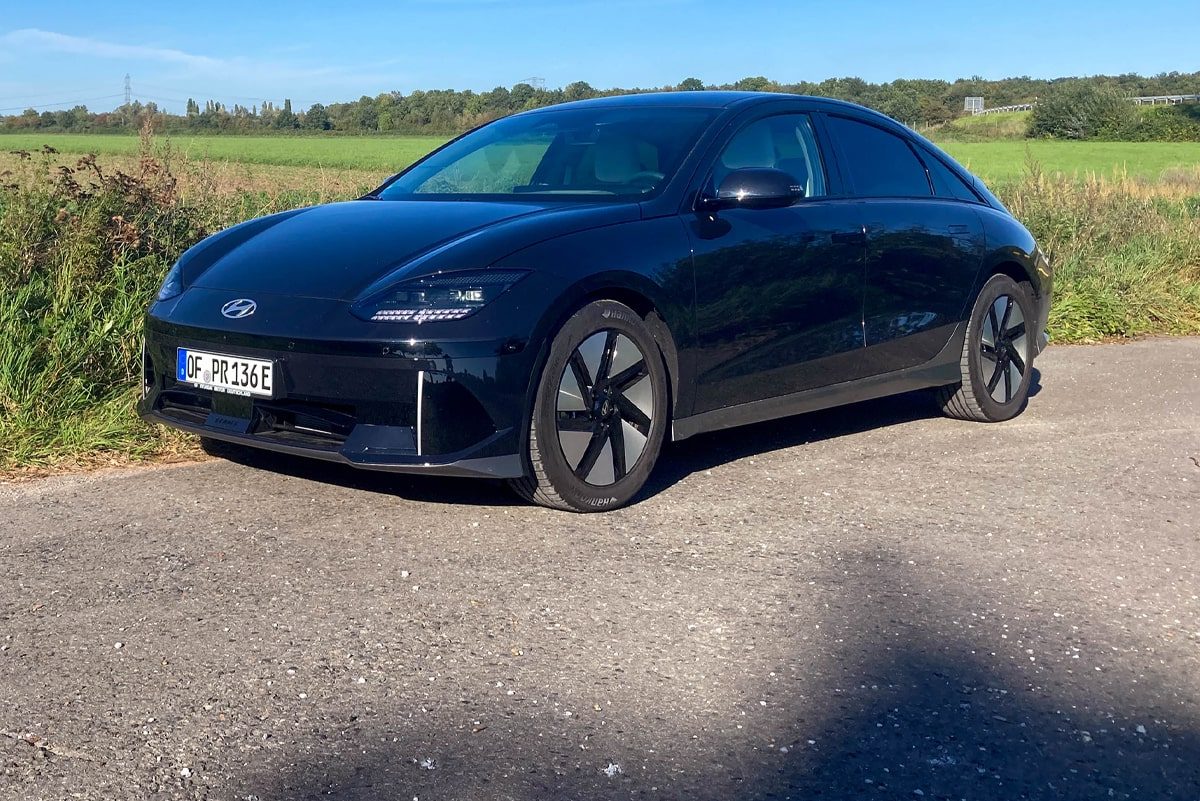
Hyundai Ioniq 6: The kept promise
When Hyundai’s first 800-volt electric car, the Ioniq 5, launched, it was met with excitement: finally, a super-fast charging electric car without a Porsche price tag. But for some, there was also great disillusionment afterwards. Under the right conditions, the Ioniq 5 beat every EV at the charging station, but the consumption of the edgy crossover was relatively high, especially on the motorway. You had to go to the charging station correspondingly often, and in the end (felt) no faster than with a more efficient electric car that charges more slowly.
The Ioniq 6 is supposed to combine the best of both worlds. It has the same charging and drive technology but is packaged in a flat and aerodynamic saloon. It was no coincidence to launch the two models in this order. It was a strategic consideration on Hyundai’s part. In an interview with electrive some time ago, Albert Biermann, the former Chief Development Officer and current advisor to the Korean company, explained that a conscious decision had been made not to launch the flat saloon first. Because the platform is so efficient, it would also allow bringing cars onto the market with a body not only designed according to aerodynamics, like the angular Ioniq 5. A later model – the Ioniq 6 – would show what is technically possible with optimised aerodynamics. Hyundai has kept its promise to bring a genuinely efficient electric car onto the market.
The differences between the two models become clear at first glance. Hyundai has not developed an “Ioniq design” and applied this design language to as many models as possible, but each vehicle has its own character. In the case of the Ioniq 6, aerodynamics dictate some of the basic shapes. The curved lines of the roof arch and shoulder section with a sloping rear come closest to the optimum shape. Regardless of whether you compare studies such as the Mercedes Vision EQXX, the (failed) solar electric car Lightyear 0 or other aero concepts from the past, if you want to optimise airflow, many cars look similar from the side. Even the designers cannot outsmart physics.
Aerodynamic bodywork meets angular pixel design
So, if the basic shape is the same, the details make the difference. Design is always a personal thing, but in my opinion, the Ioniq 6 didn’t manage it perfectly. The Ioniq 5 may not be everyone’s cup of tea either, but in my eyes, it had a coherent design – the pixel design of the lights goes well with the angular appearance with lots of straight lines. The Hyundai designers also picked up on the pixel element in numerous places in the Ioniq 6, but for me, it doesn’t harmonise well with the curves and sweeping lines. The Prophecy study, from which the Ioniq 6 emerged, was more harmonious – again, in my opinion.
However, electrive is not about design but about technology and driving impressions. For the test, Hyundai provided the battery-drive combination with the longest range, the 77.4 kWh battery with the 168 kW rear-wheel drive, which should be enough for 614 kilometres according to the WLTP standard. The large battery is also available with a 239 kW all-wheel drive (583 WLTP kilometres), while the base model has a 53 kWh battery with a 111 kW rear-wheel drive, which results in 429 kilometres in the standard test.
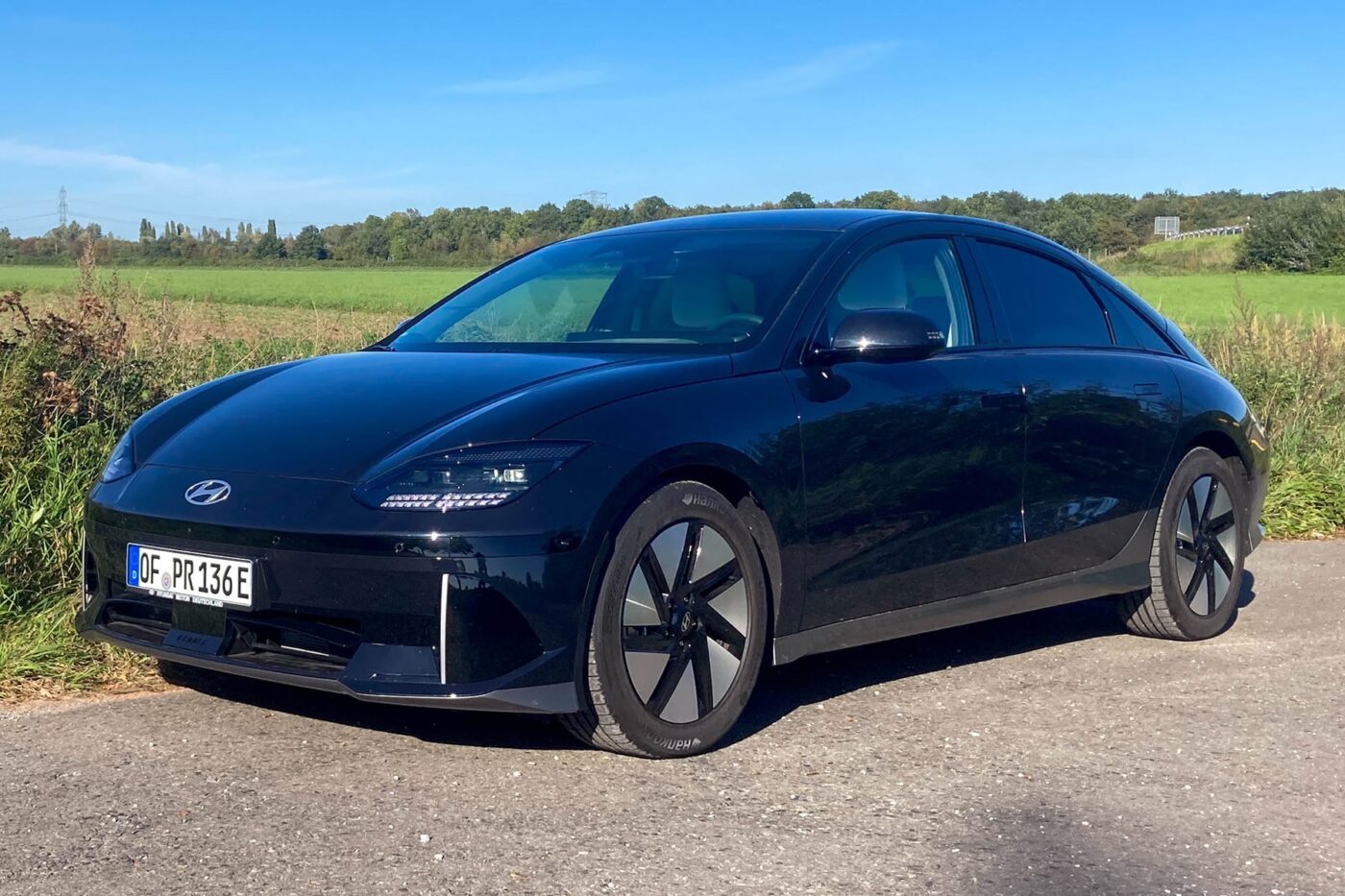
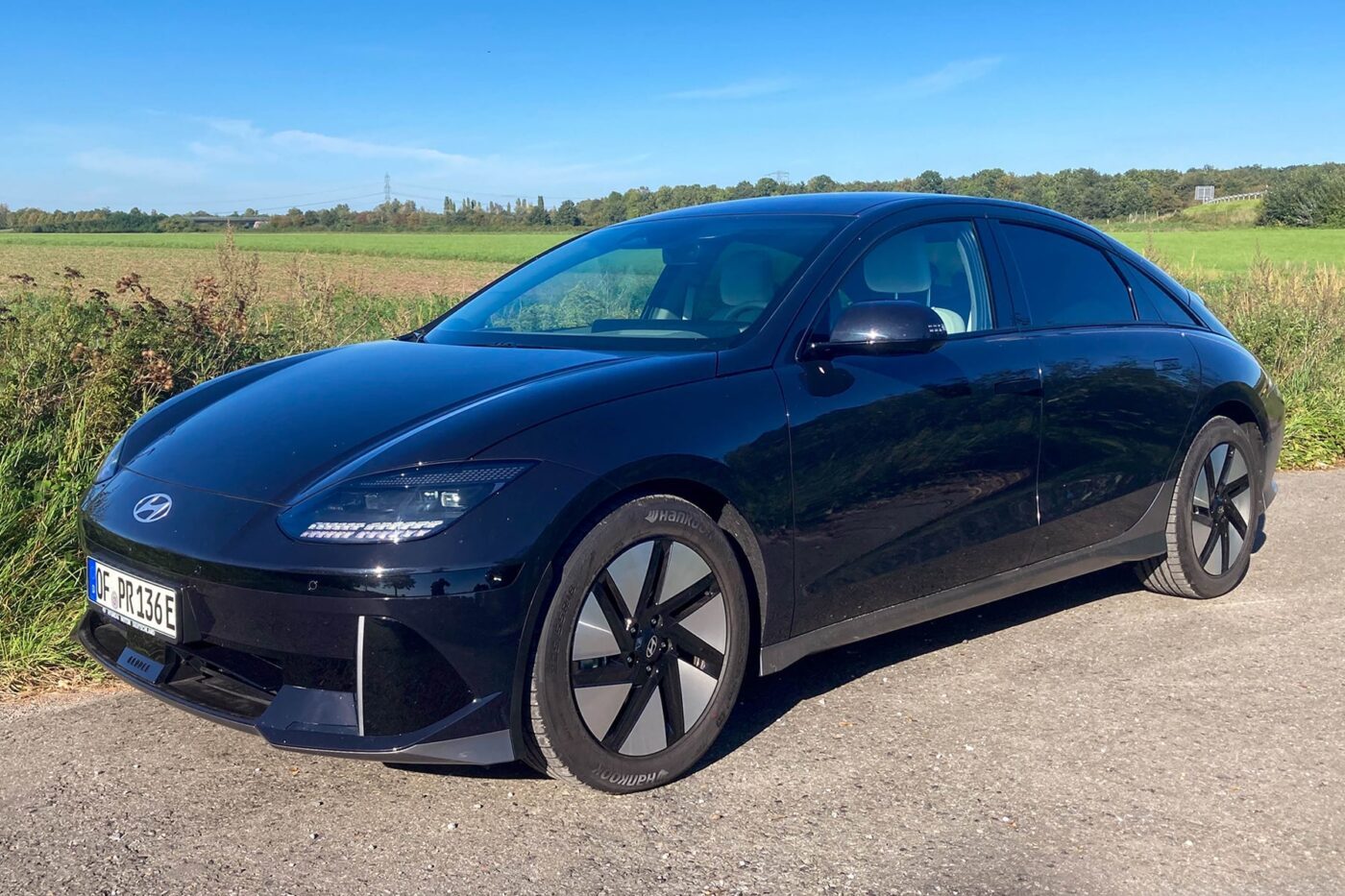
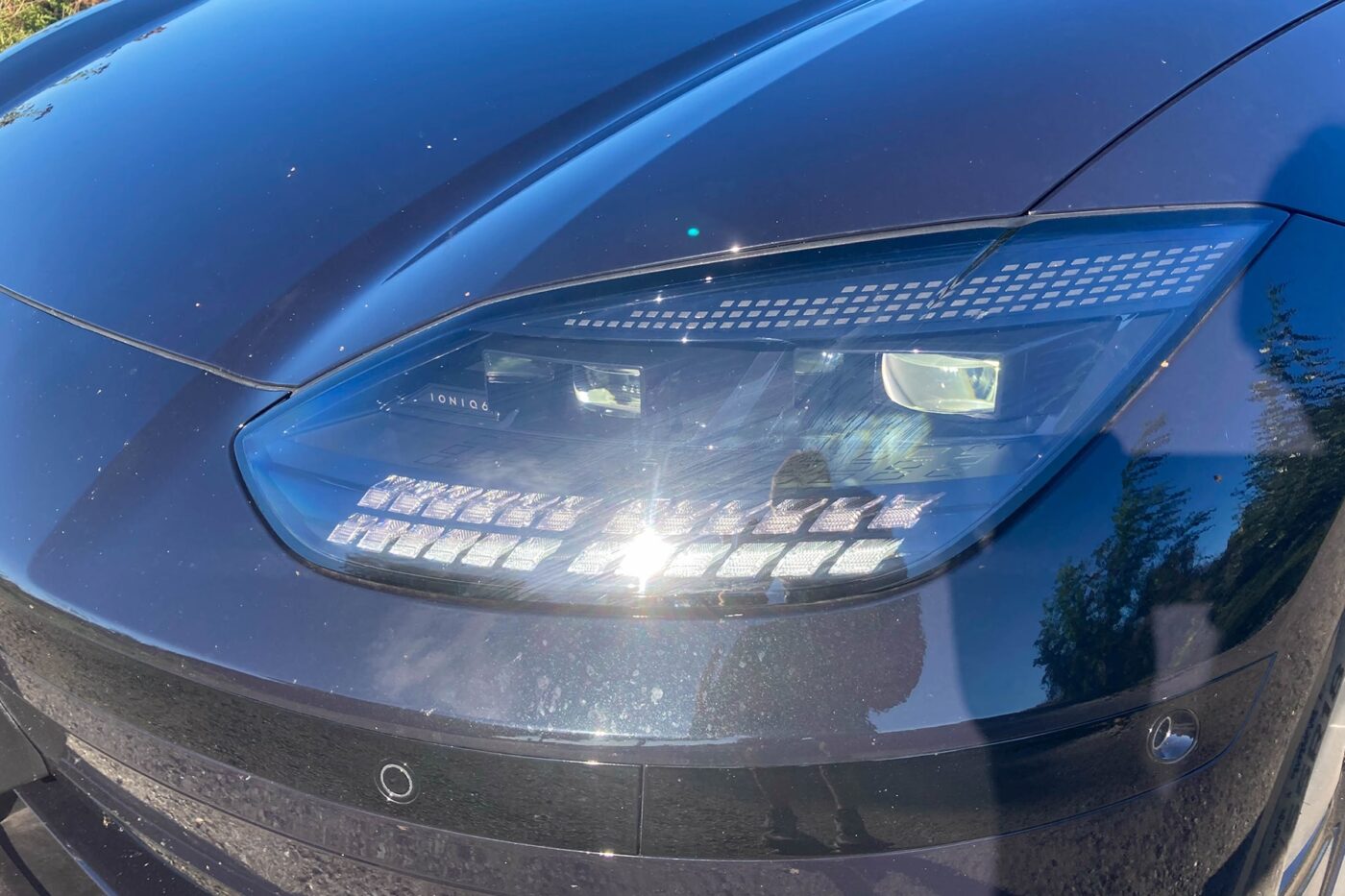
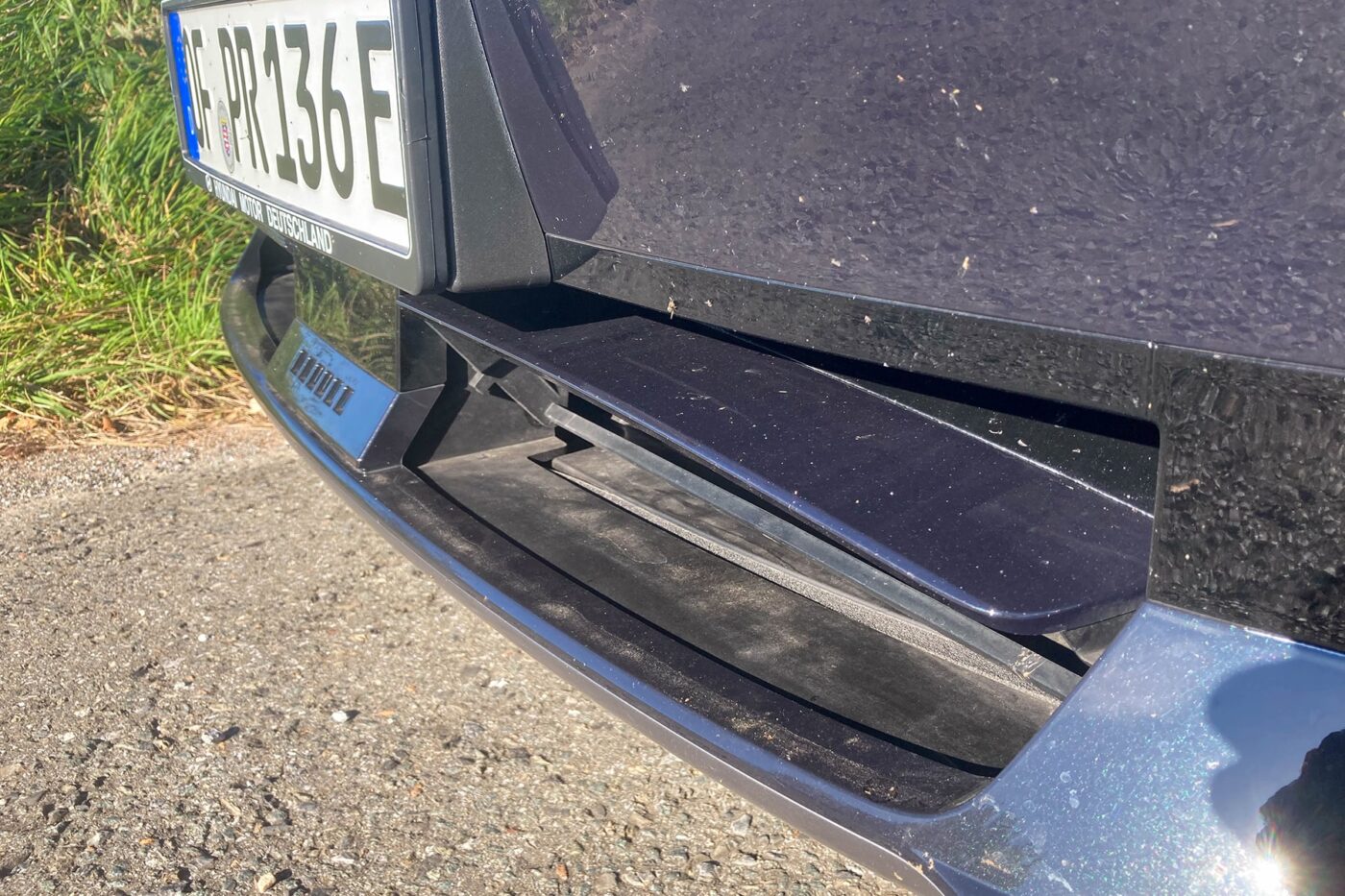
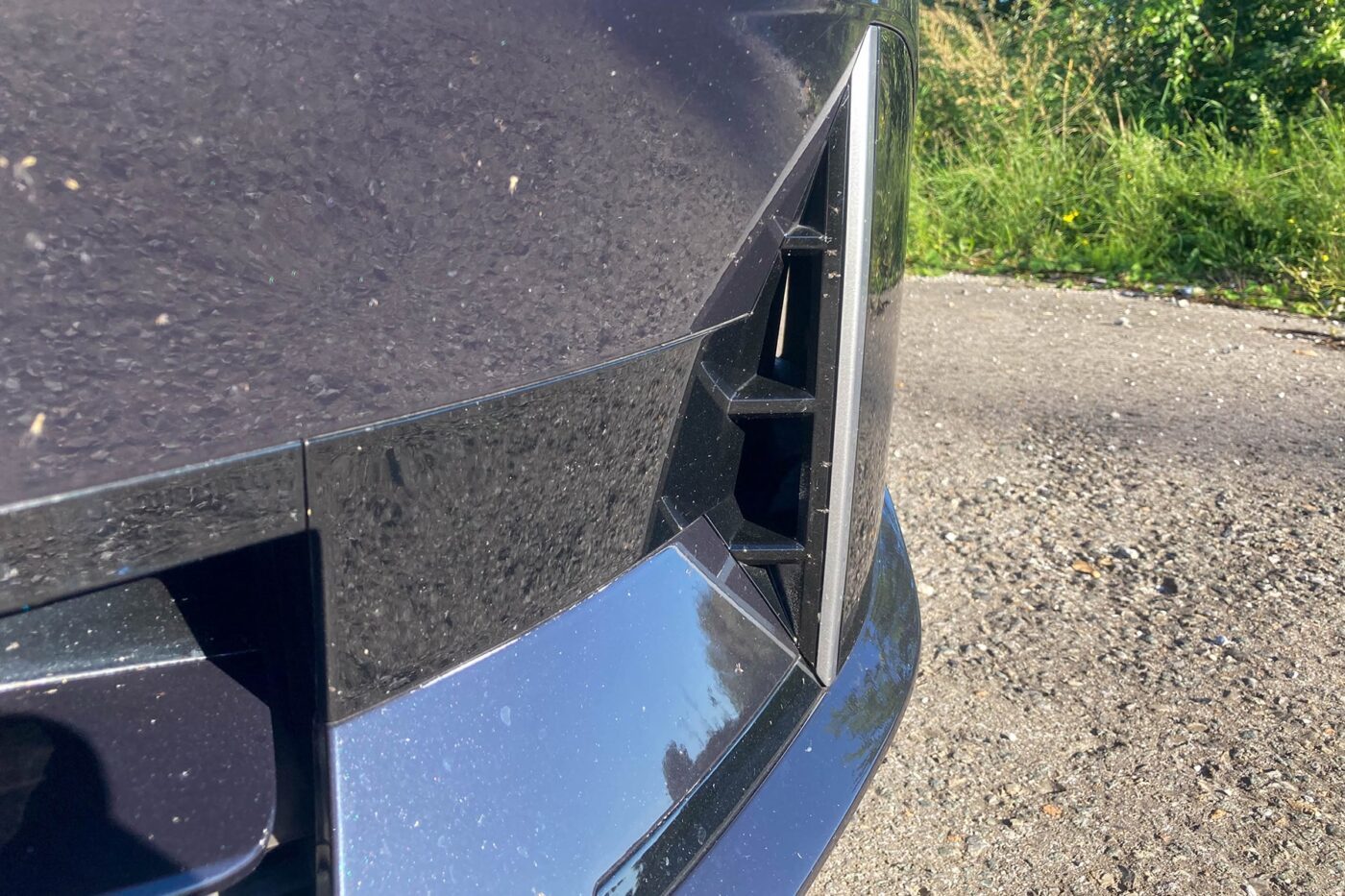
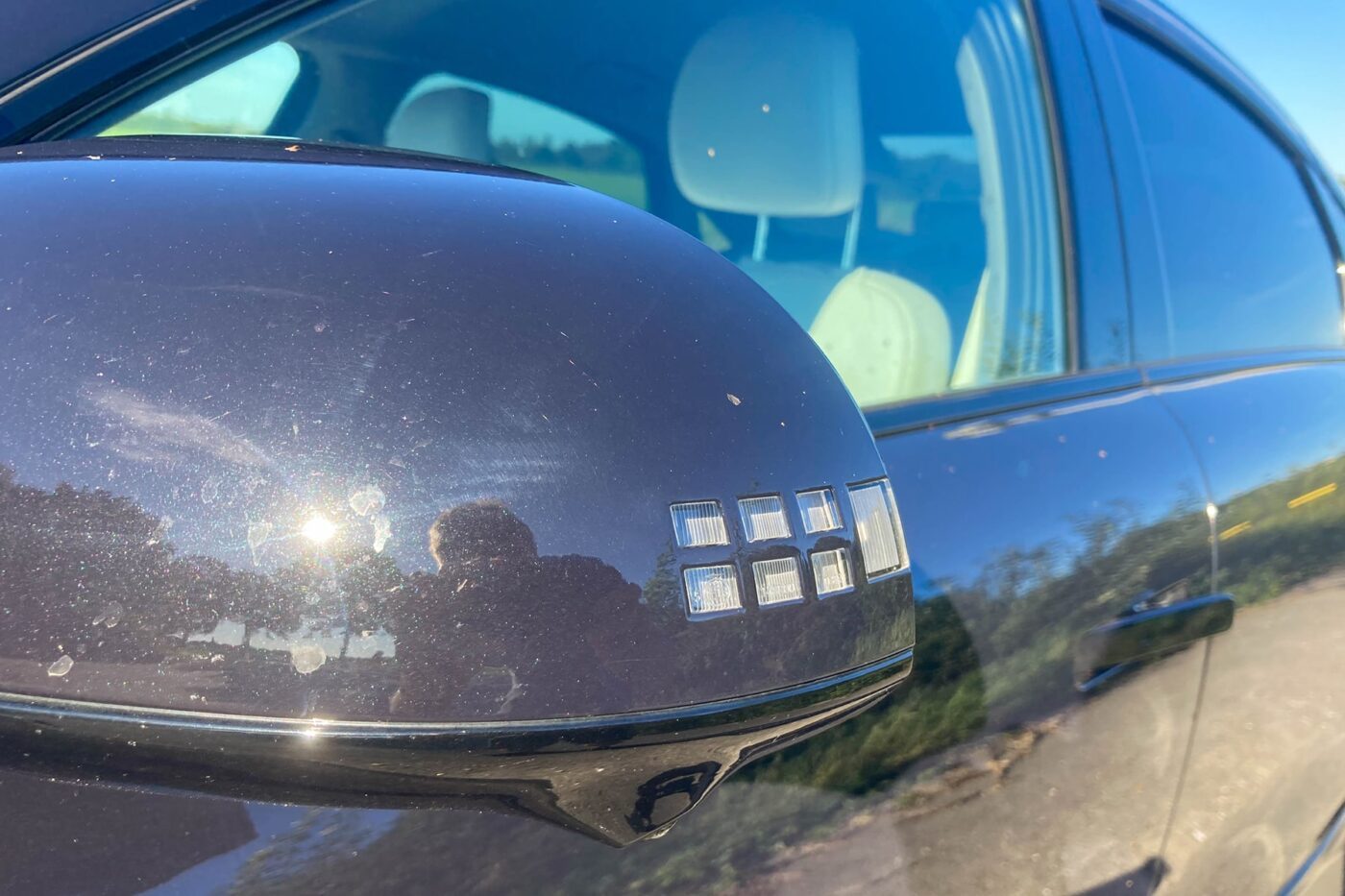
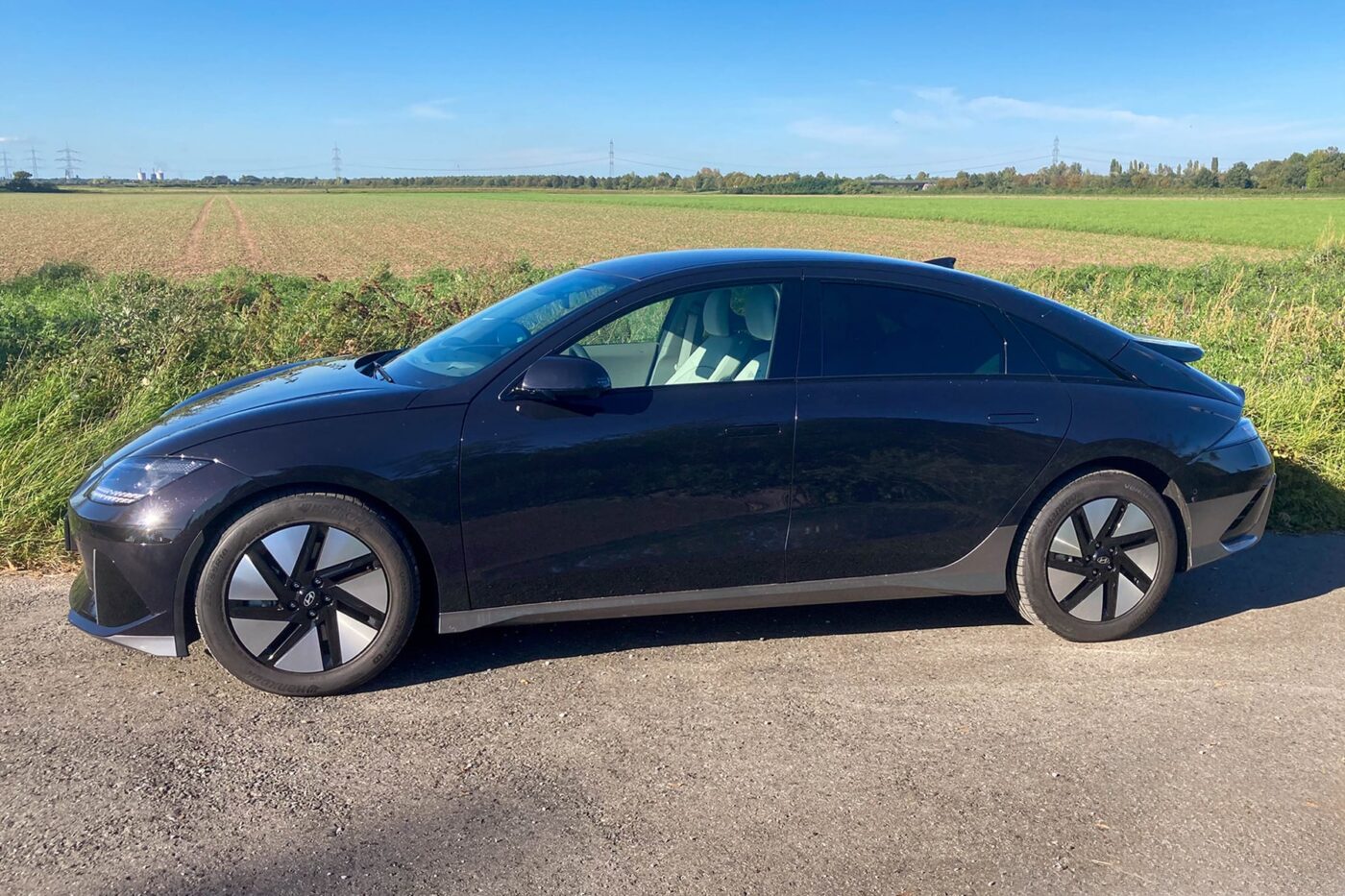
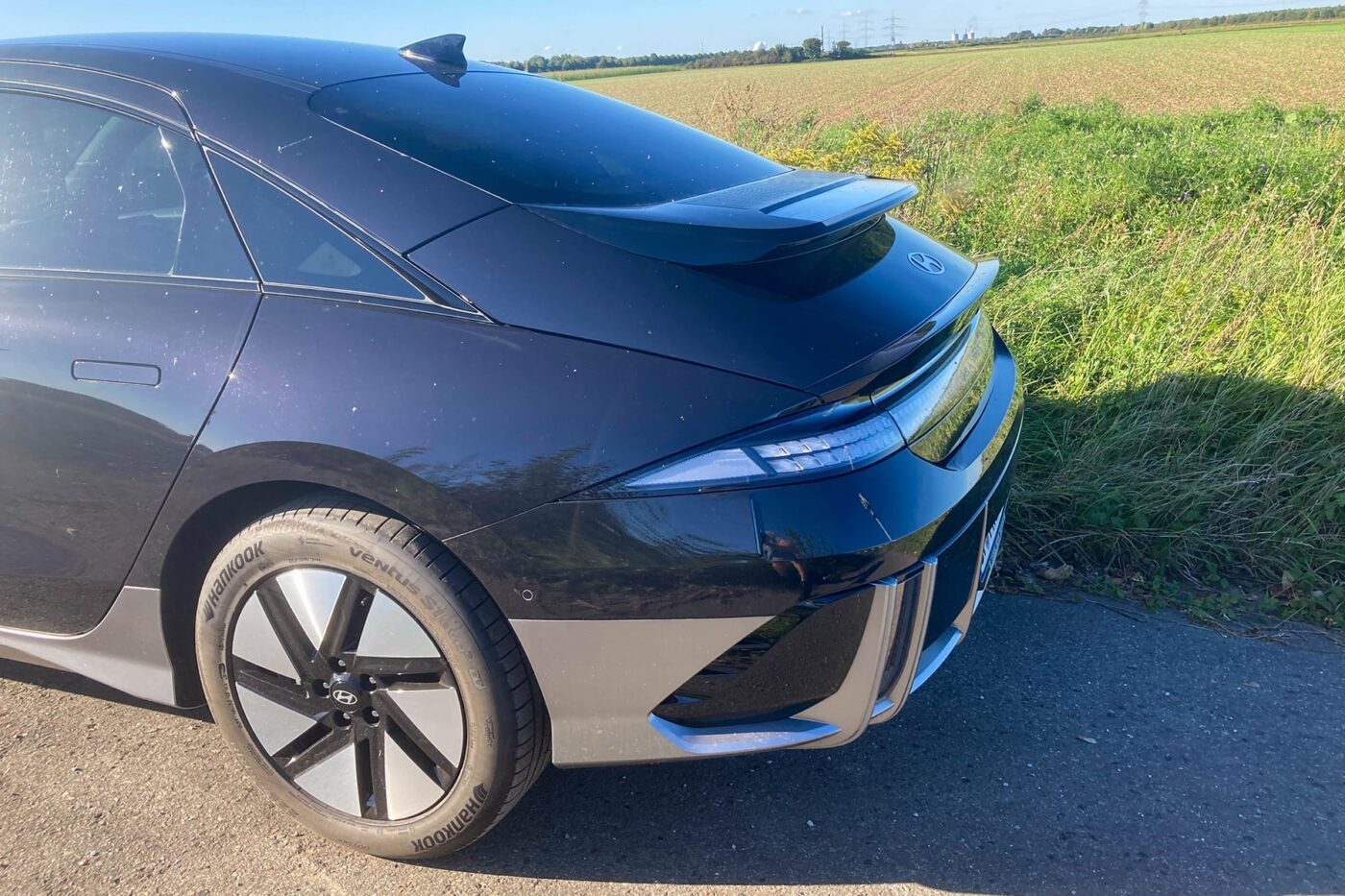
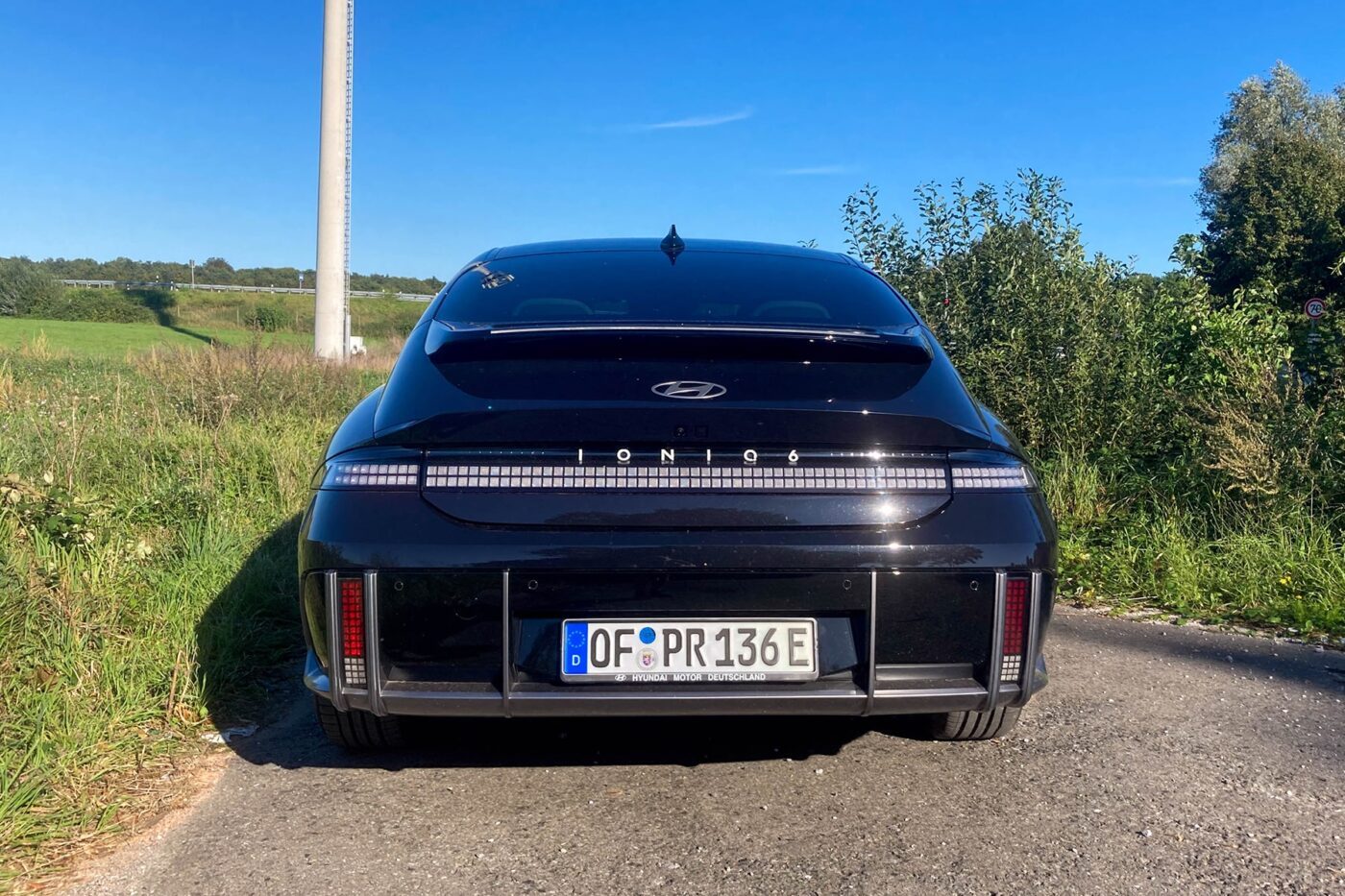
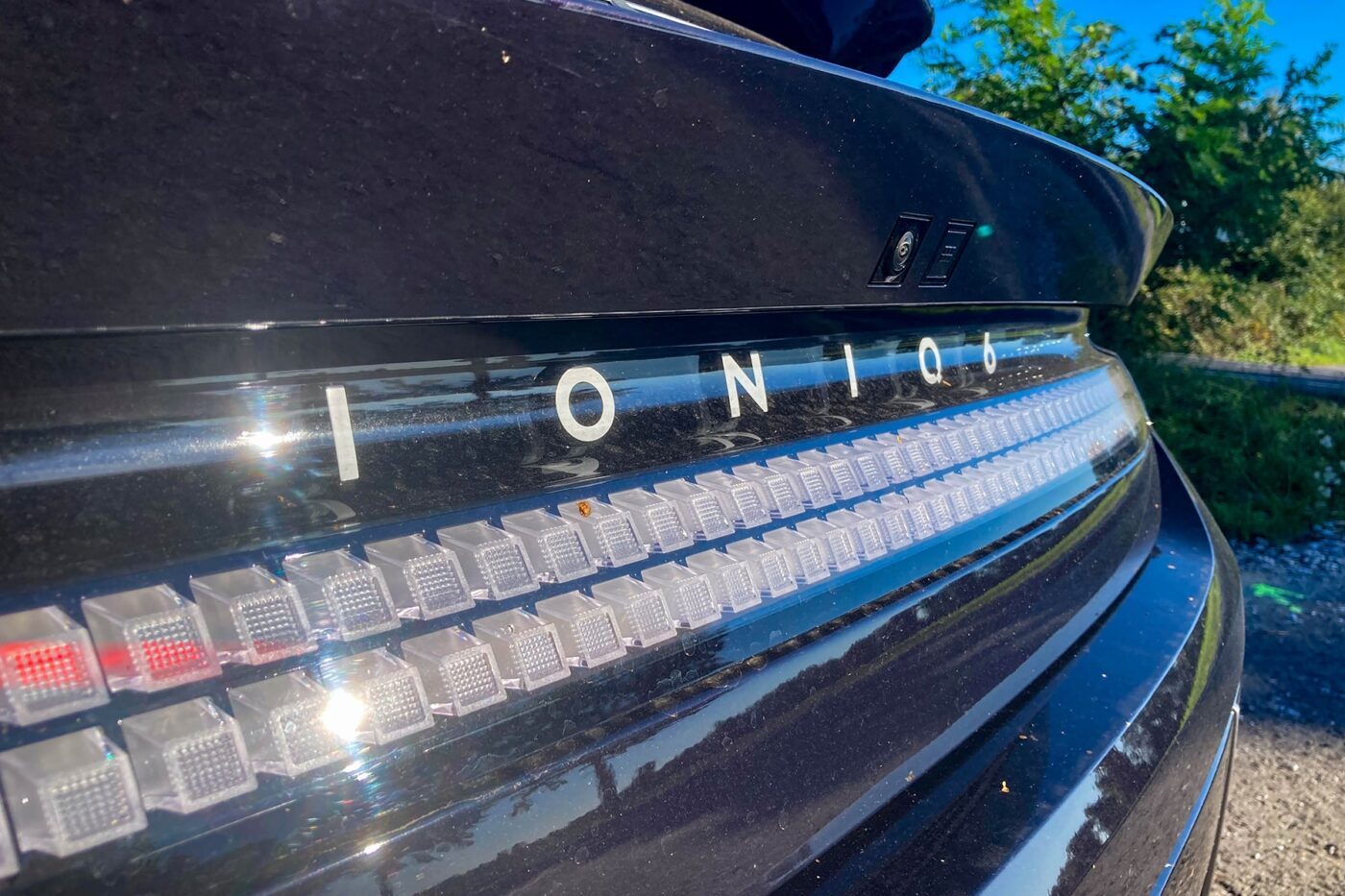
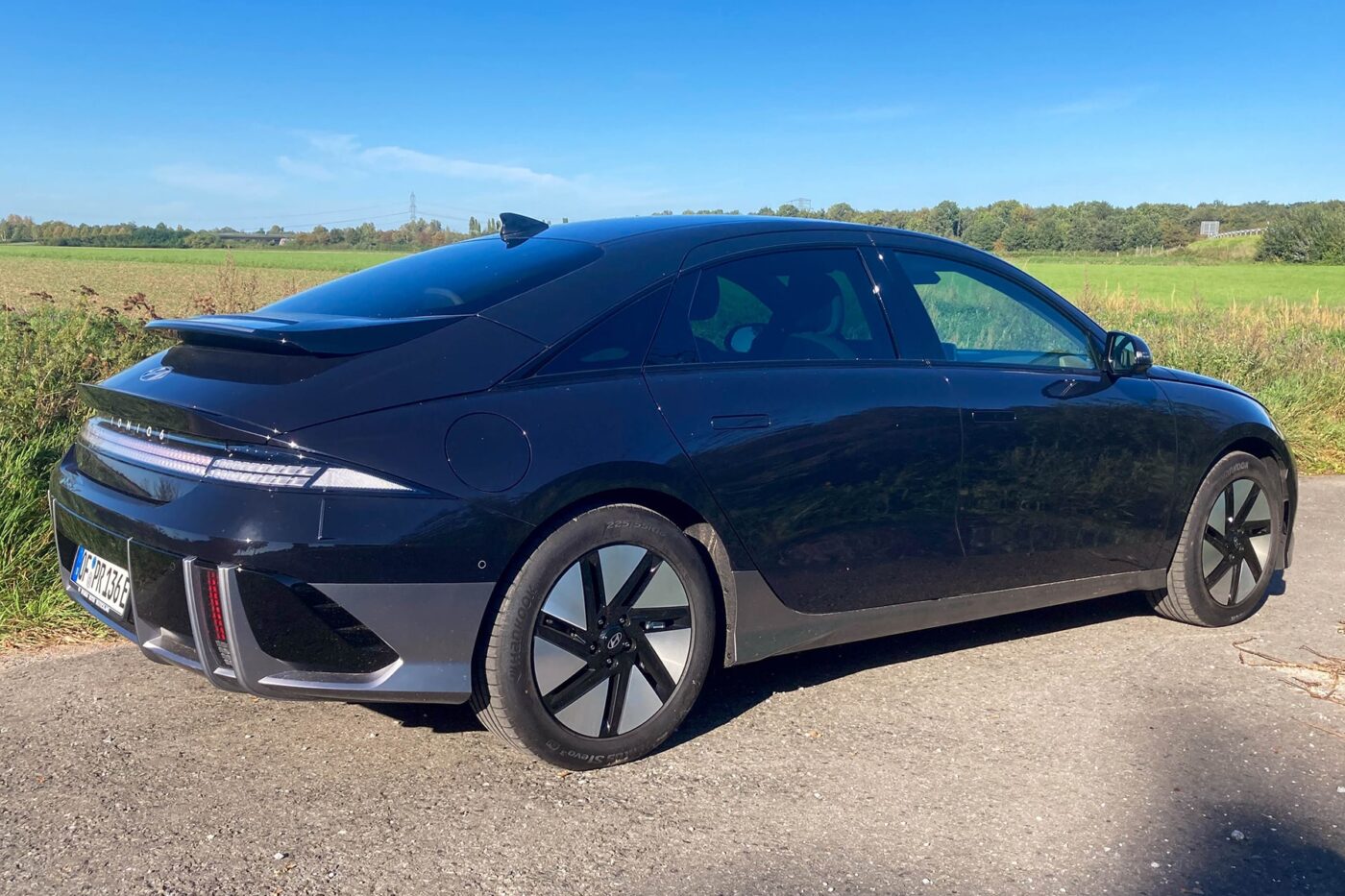
Our test car also had the aerodynamically better 18-inch Aero rims; depending on the equipment, visually attractive 20-inch alloys are also available, but they are worse for airflow – at 245/40 R20, these tyres are also wider than the 225/55 R18 ex works tyres fitted to our test car. At the end of our 897 kilometres with the Ioniq 6, we were able to achieve a consumption of 14.3 kWh/100km according to the onboard computer – admittedly in conditions of around 20 degrees. That is precisely the WLTP value for this drive variant. It results in a calculated range of 541 kilometres. A small note: Although we have achieved the WLTP consumption, this does not result in the WLTP range because the consumption is measured from the AC charging point. The WLTP consumption figure also includes AC charging losses, so the WLTP range cannot be directly deduced from this value, as the range is only determined in the vehicle (i.e. without charging losses).
At a SoC of 85 per cent, i.e. at the end of a fast charging process, the onboard computer shows a range of 470 kilometres. Although the pure motorway consumption is slightly higher than the result of our test average, the display has levelled off at 17-18 kWh/100 km at the recommended speed, which still corresponds to 430 kilometres. On relaxed sections of the journey – as mentioned above at ideal temperatures with low energy consumption for heating or cooling – consumption of 11-12 kWh/100km was also possible.
Charging times are first-class
The differences to the Ioniq 5 are clearly noticeable in terms of consumption. Regarding charging, however, both models are the same. They both have an 11 kW AC charger, and the Ioniq 6 can supply external devices with up to 3.7 kW using the optional vehicle-to-load adapter. The 77.4 kWh battery can be charged with up to 240 kW at peak times and even over a relatively wide range – 18 minutes from ten to 80 per cent is still a peak value. If there is a planned charging stop along the route, the system automatically preconditions the battery. Therefore, the optimum charging window can be reached much more frequently than with the first Ioniq 5, which still had to manage without preconditioning.
However, preconditioning the battery is not only crucial in winter or hot weather, but is also recommended before all DC charging stops. Even at a supposedly ideal 20 degrees, the Ioniq 6 did not achieve the ideal charging curve if you made an unplanned stop at a DC charging station. However, the disadvantage here was minimal in our test: even if the Ioniq 6 does not reach the maximum possible output, it still charges faster than many competitor models. Fast charging is simply one of the car’s strengths.
On the other hand, there is a deduction for the route planning, which Hyundai should improve. The selection of suggested charging locations is fine; in our test, for example, no charging points were suggested in supermarket car parks if these are not accessible on a Sunday. However, the route is not optimally calculated, as each charging stop is planned up to the fixed 80 per cent charge level. An example: With 85 per cent SoC at the start in Düsseldorf, the Ioniq 6 plans two charging stops for the route to Munich. If you don’t want to exhaust the battery fully, this is plausible for the 631-kilometre route, and perhaps it would also be possible with one charging stop. What we are getting at: The fact that the first charging stop at Ionity is planned from 14 to 80 per cent (in a predicted 14 minutes) is acceptable. However, it is not enough for the system for the rest of the journey to Munich, so another stop is suggested later at a Fastned station. It takes 16 minutes to charge from 22 to 80 per cent, and then 109 kilometres later, you arrive at your destination with 57 per cent in the battery. We did not enter such a high charge level at the destination in the system; this is the result of the fixed charging target of 80 per cent. The second charging stop could have been completed much earlier, or the first charging stop could even have been planned so that you could reach your destination directly with a charging process of 5-85 per cent.
No question: 30 minutes of charging time over a distance of more than 600 kilometres is an excellent value and only possible with a few vehicles in this price range! The Hyundai does this really well. However, with slightly better software, it could have been just 22 minutes. Such a function is certainly not trivial, but with the real-time data from the vehicle, Hyundai could achieve a much better result in terms of charging planning. Customers may then switch to (Carplay and Android Auto-capable) smartphone apps that enable such dynamic charging planning.
In general, however, the efficiency of the drive and the fast charging system make the Ioniq 6 an excellent long-distance car. For the 563 kilometres from Düsseldorf to Berlin (also calculated with 85 per cent SoC at the start), a charging stop of only 16 minutes is required. If you have a wall box at home and can start with 100 per cent, the charging process is even shorter. These breaks would also be necessary on this route with a combustion engine. With the Ioniq 6, there is no longer any difference, not least because the charging planning works reliably (despite the weakness in detail with the 80 per cent) and suggests a sensible route. Even if you have to drive to Berlin spontaneously and the battery in the car is only half charged, a second charging stop is calculated – with an indicated total charging time of 35 minutes, in practice relatively less due to the rigid 80 per cent planning.
Plenty of space inside, just not in the boot
But can the Ioniq 6 also score points outside of the drive system? Our test impression here is somewhat ambivalent. The chassis offers a decent level of comfort, and most of the driving assistance systems, such as Highway Assist 2.0, are good. In terms of space, there are pros and cons to the concept: With a wheelbase of 2.95 metres and the completely flat interior floor of the electric platform, there is plenty of legroom for passengers in the front and rear and, despite the curved roof arch, people up to around 1.85-1.90 metres can sit well and quite comfortably in the back.
At 401 litres, however, the boot is relatively small, and with four adults, luggage should be very compact. As the boot is also very angled with the rear wheel arches and around the through-loading facility on the back seat backrests, the 401 litres cannot necessarily be used optimally. For example, at its widest point, the boot measures 1.21 metres, with 1.04 metres between the wheel arches. The load-through hatch with the rear seat backrests folded down, on the other hand, is only 97 centimetres wide. And even the maximum height of 45 centimetres cannot be used in the entire boot. This is where the aerodynamic shape has an impact on the utility value. After all, the rear-wheel drive model has a decent frunk under the front bonnet.
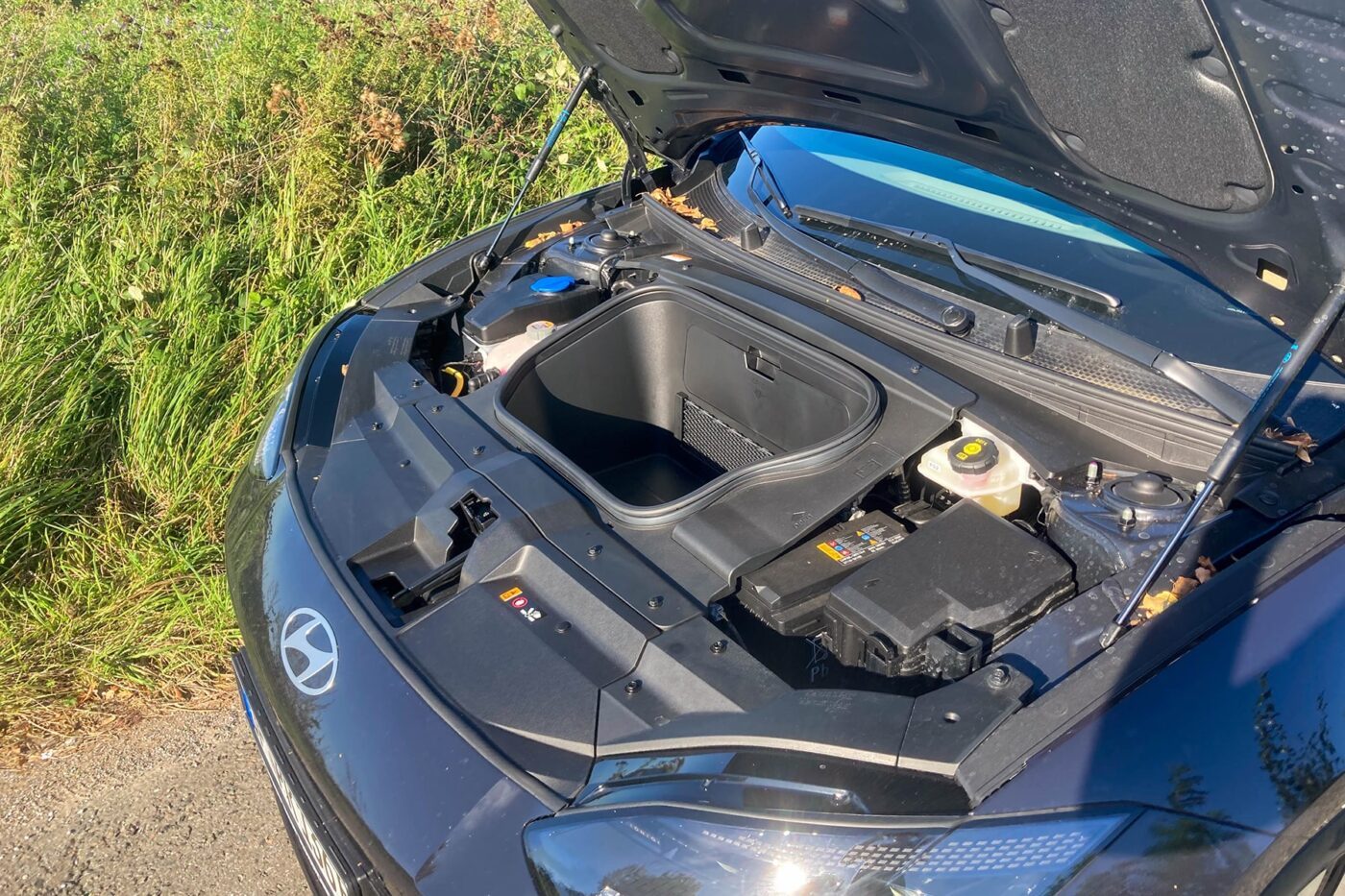
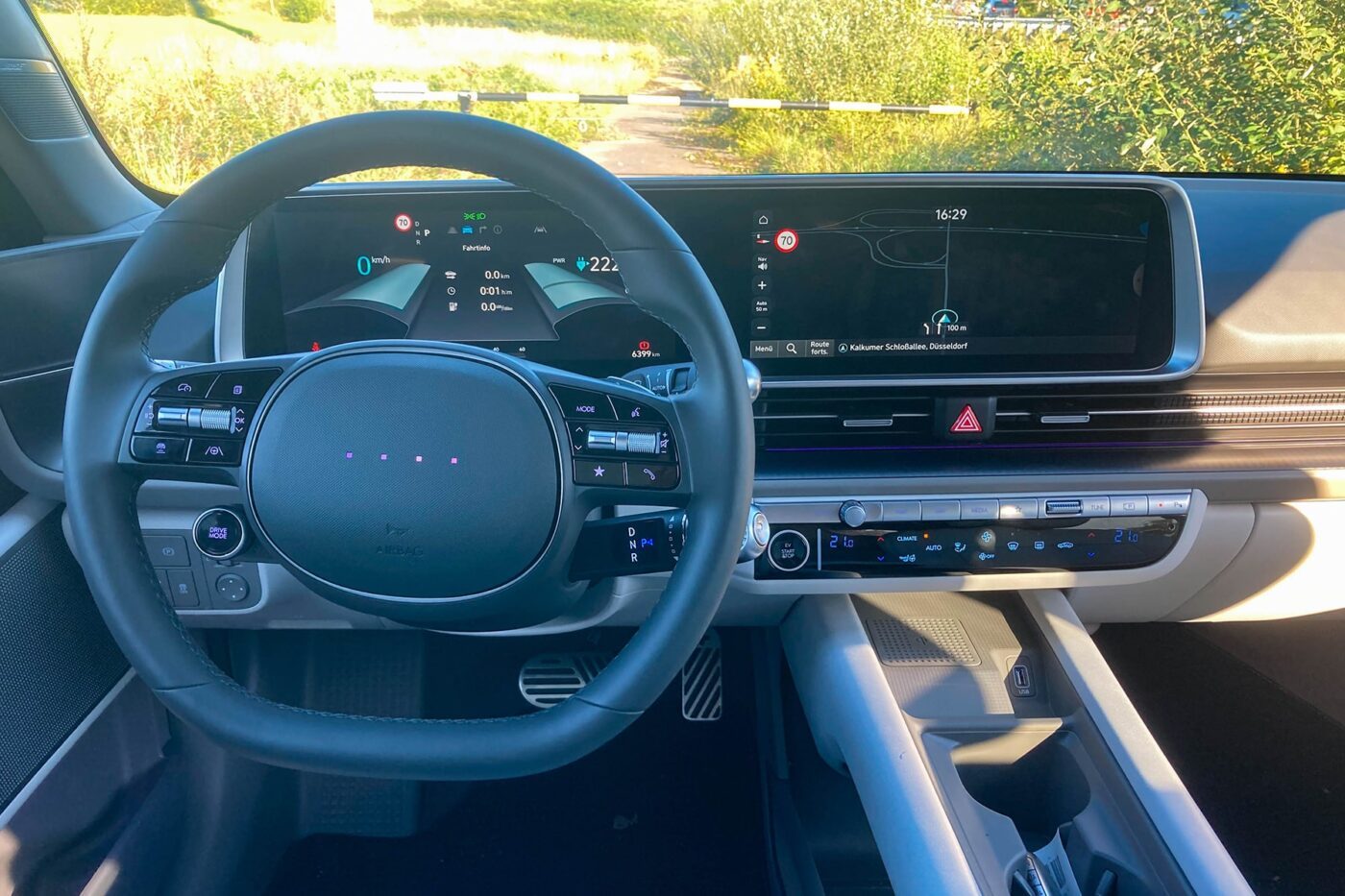
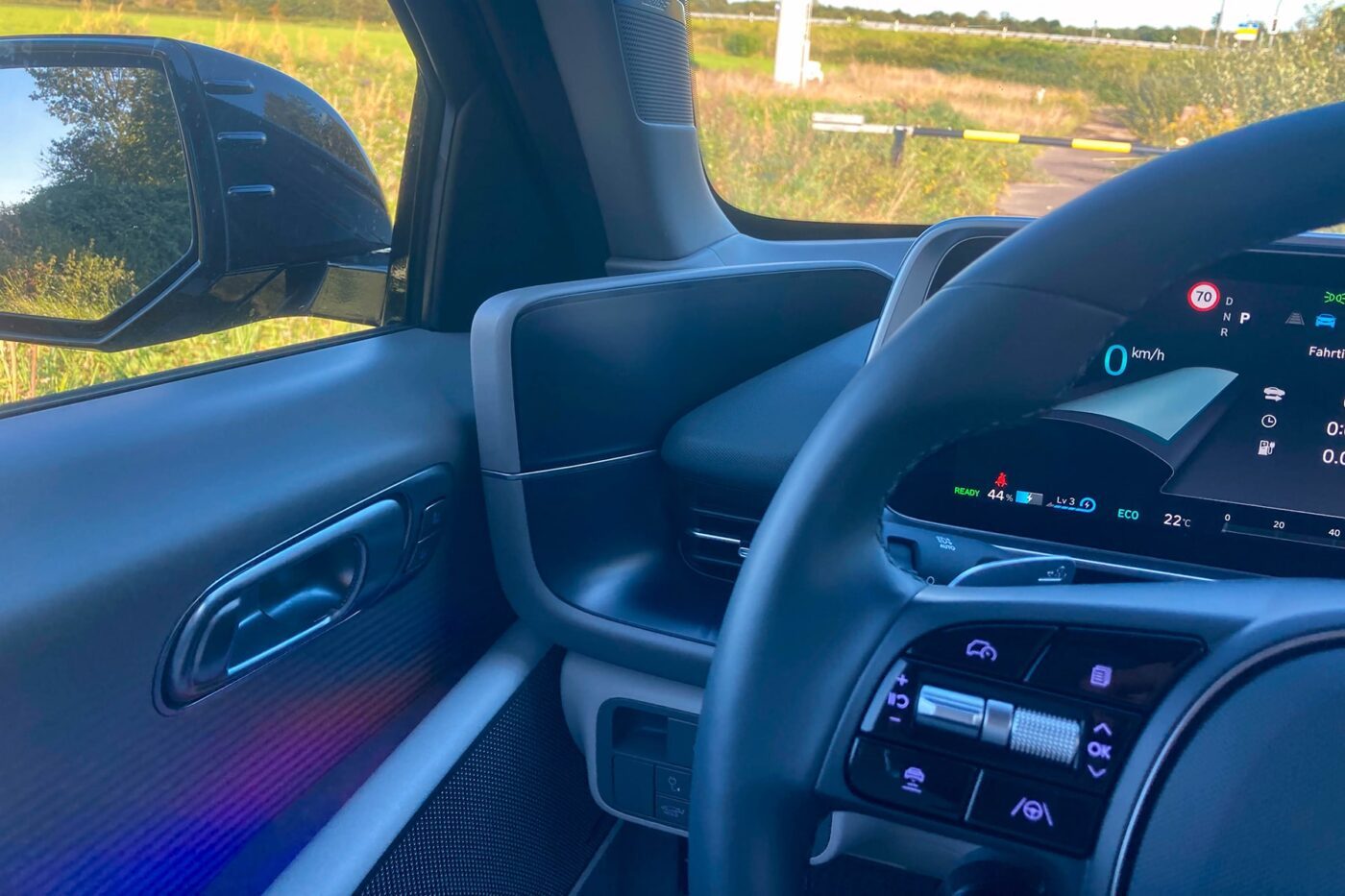
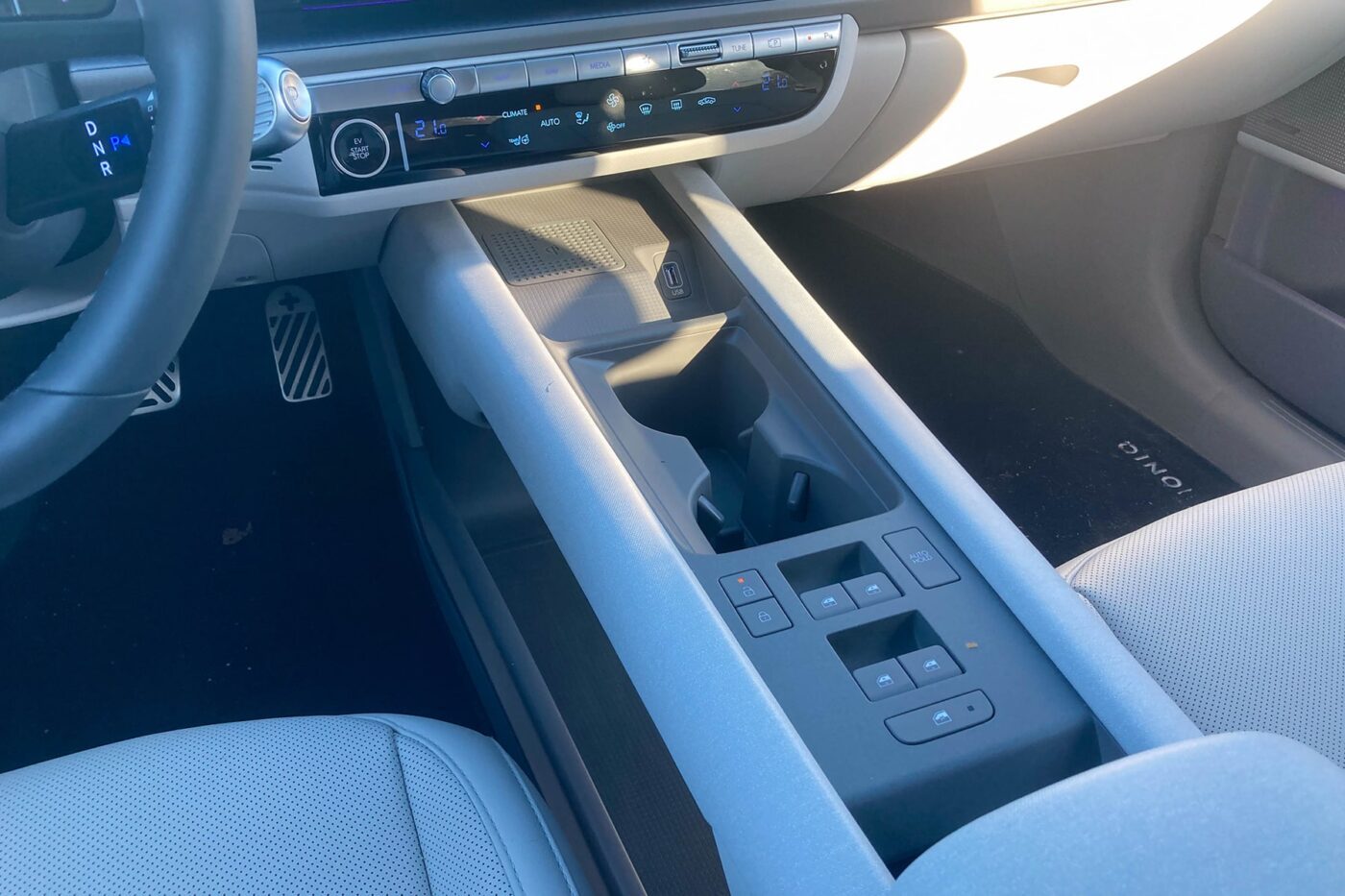
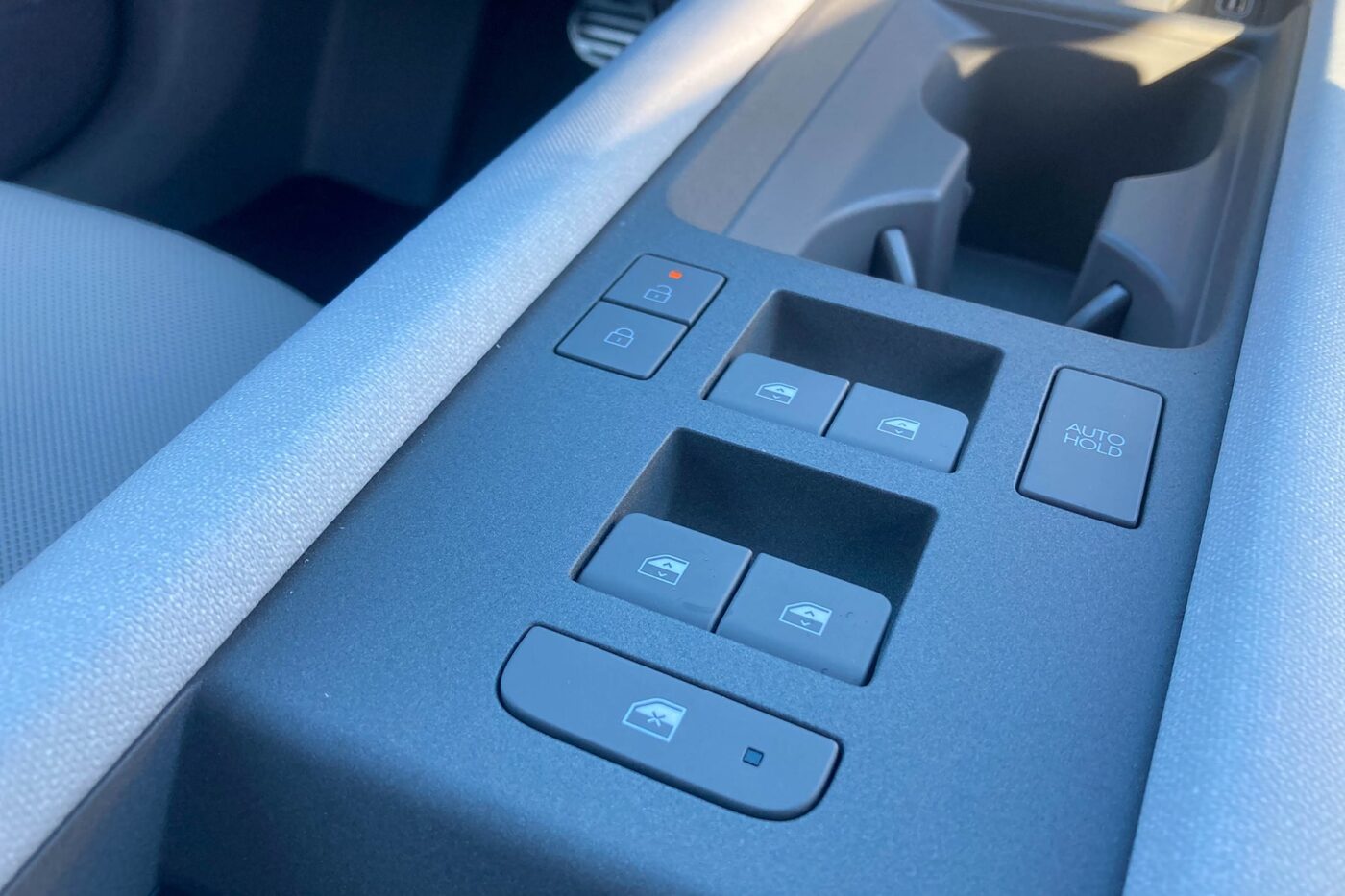
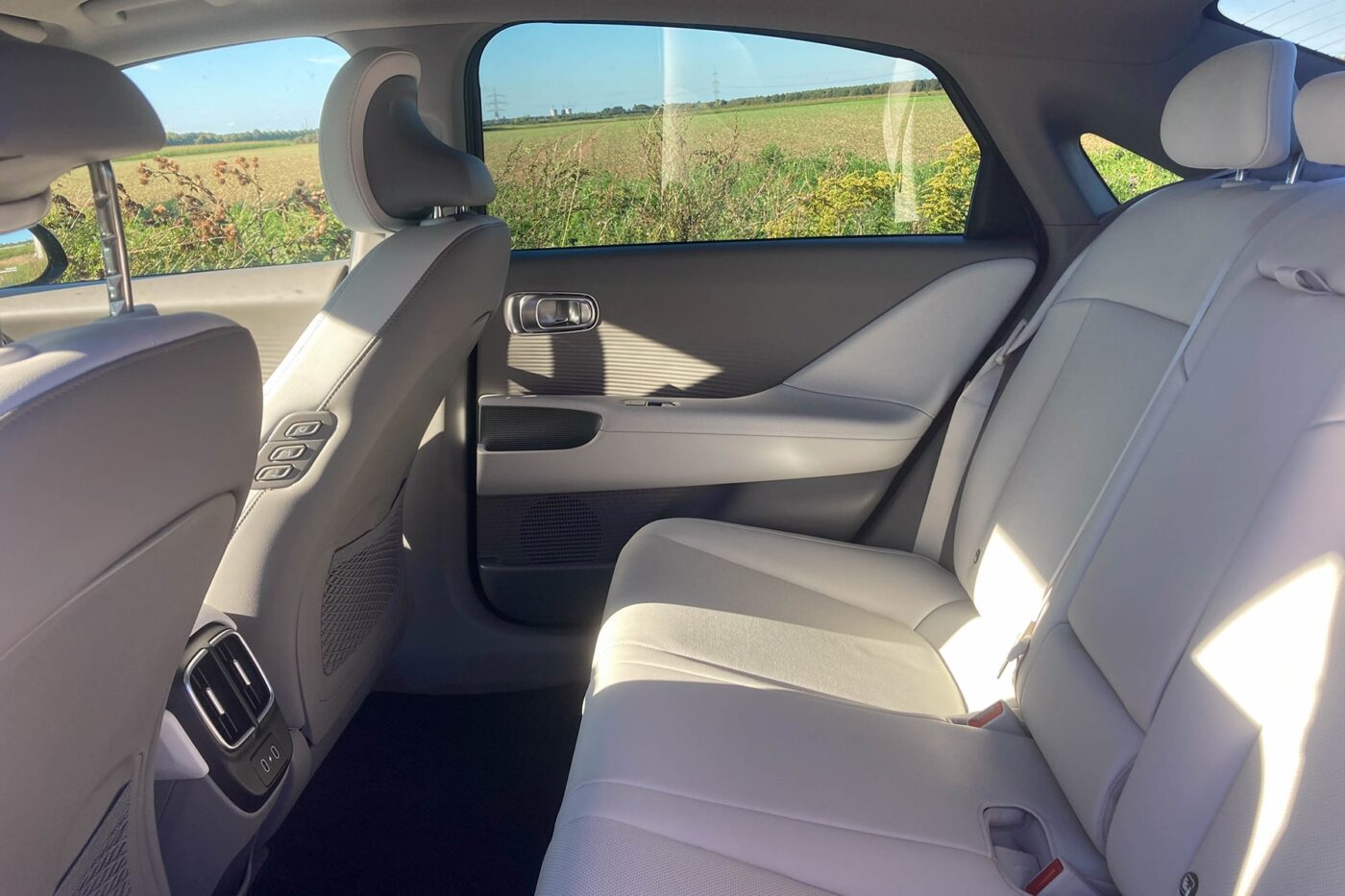
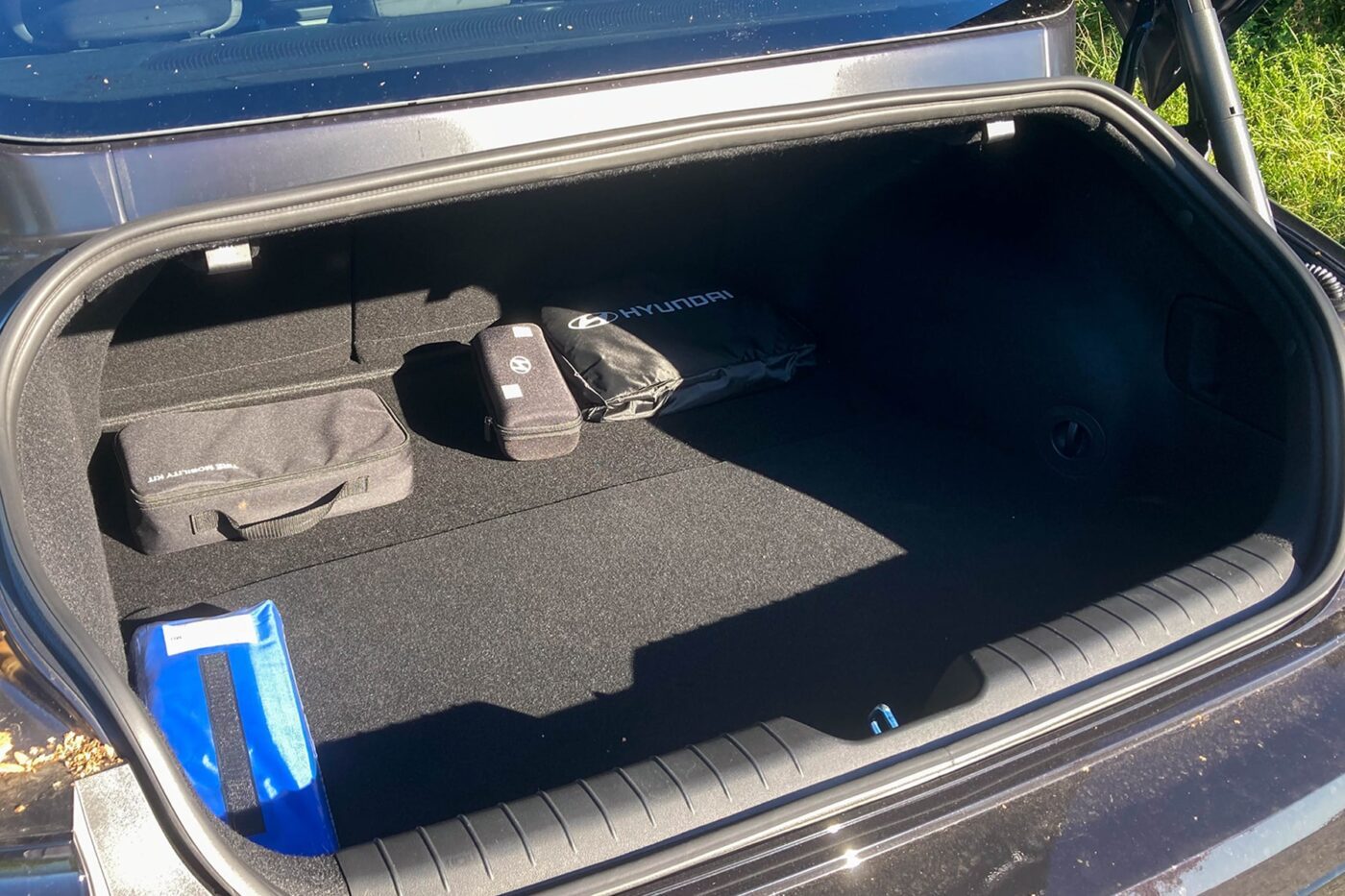
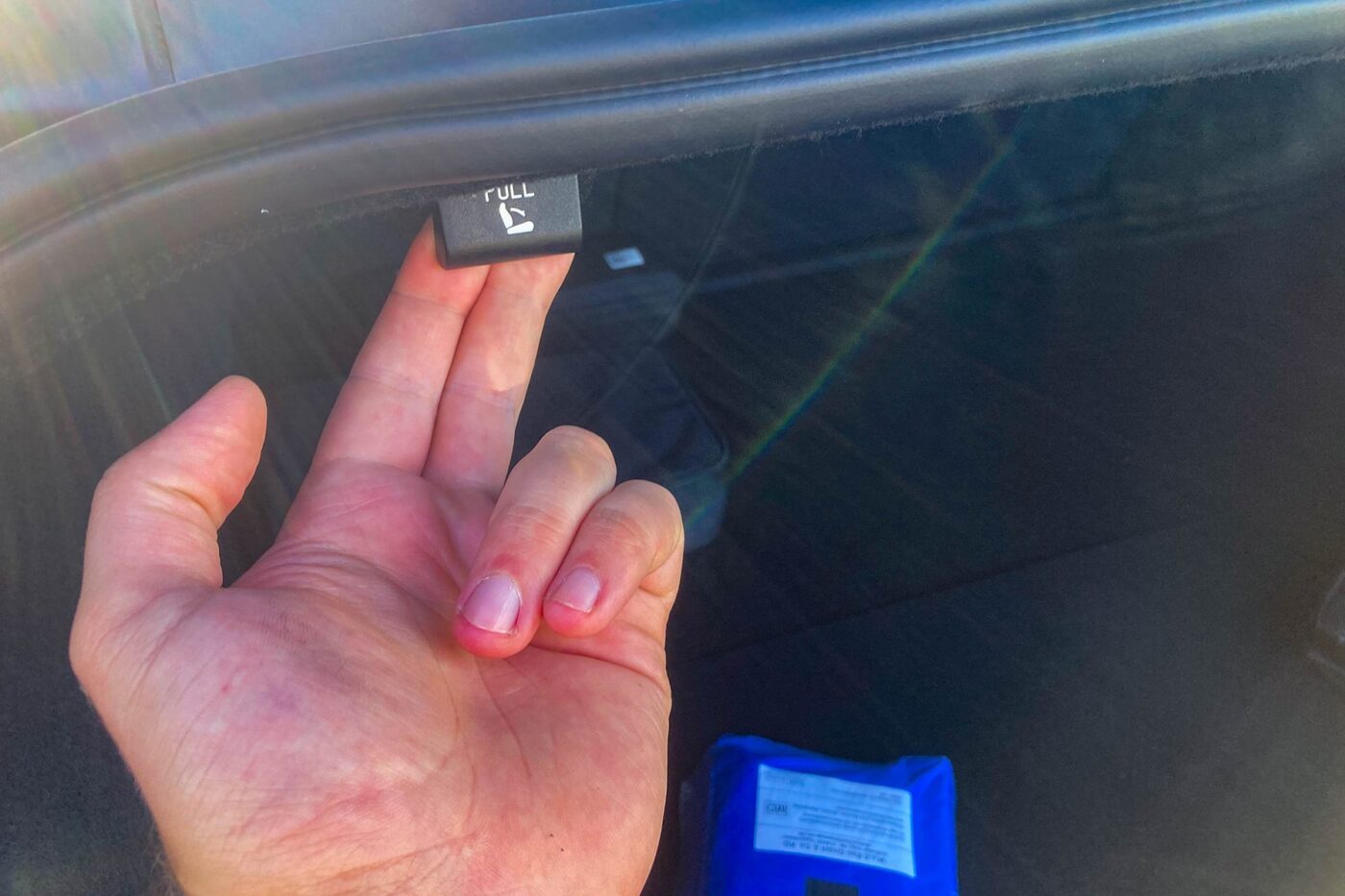
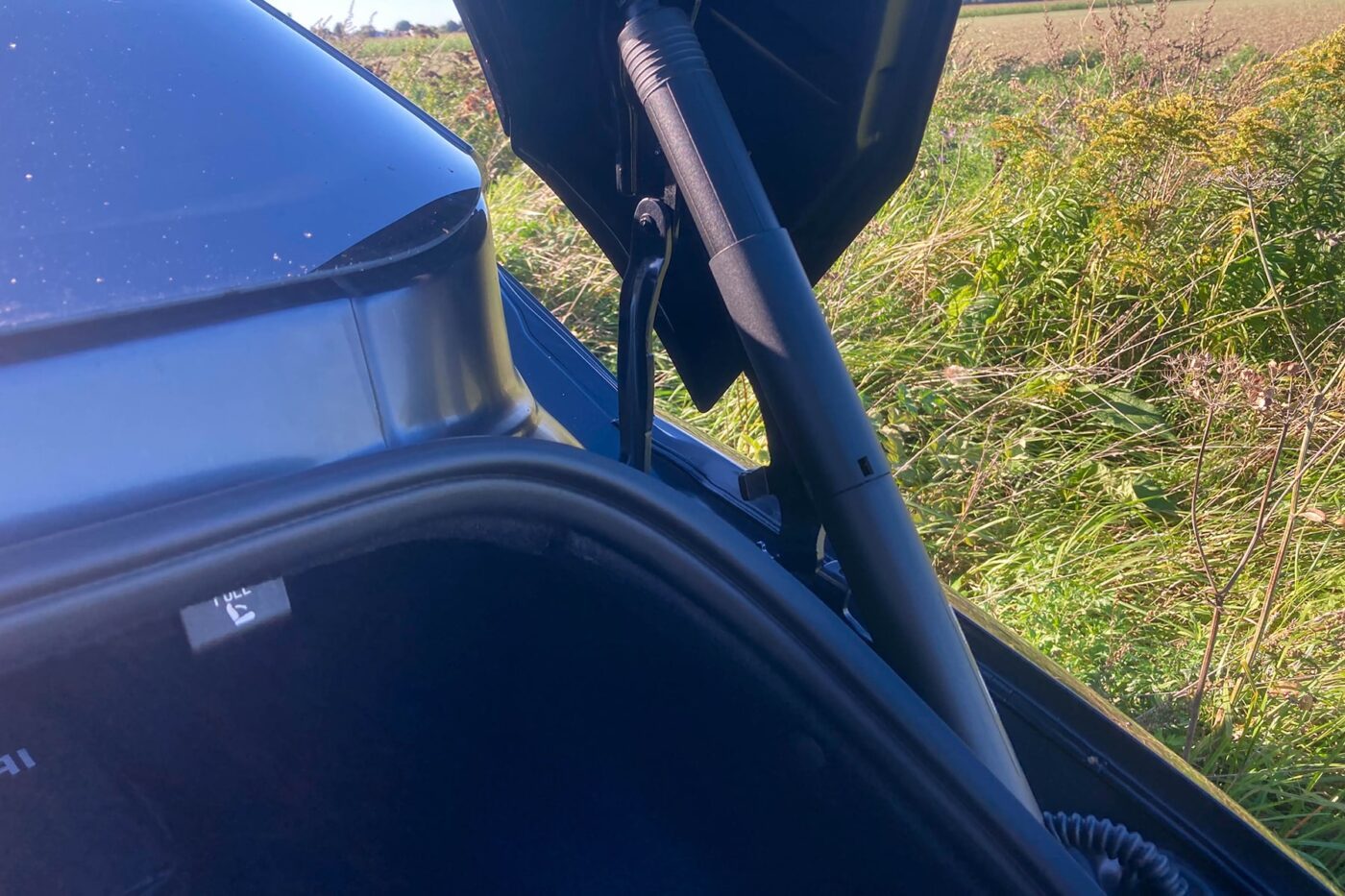
While such compromises are inevitable in an aerodynamic saloon with a flat rear, other points of criticism have nothing to do with the bodywork. The interior may look stylish, but in practice not every decision made by the designers convinced me. At the premiere, Hyundai explained that they had deliberately decided to keep the front door panels very “clean”. This is why the usual control units, such as the power windows, have been moved from the armrest in the door to the centre console. This is purely a matter of habit; during the test, I reached into the armrest in vain on one or two occasions. But this creates a very large area in the door panel and, as the dashboard is also designed to accommodate the monitors for this in the versions with camera exterior mirrors on the inside of the A-pillar, it looks very bulky overall. However, this may also have been supported by the equipment in our test car: The interior was an interplay of a wide variety of grey tones. In my opinion, the colour and the choice of materials would have benefited from a little more variety in this price range. There’s an awful lot of plastic for a car that costs over 60,000 euros in this specification.
However, I could overlook the interior materials if I simply needed a good long-distance electric car. What is much more annoying is the beeping in the Ioniq 6, not the typical Hyundai sound effects when starting the vehicle, but specifically the “intelligent traffic sign recognition” – called ISLA by Hyundai, otherwise often abbreviated as ISA. Such a system has been mandatory for all newly type-approved car models (such as the Ioniq 6) since July 2022 and will apply to all new cars from 1 July 2024. The corresponding EU Regulation 2021/1958 stipulates that a car must detect and display the current speed limit – and alert the driver if they exceed the permitted speed.
When an assistant is more annoying than helpful
It is basically a good thing because it is intended to ensure greater road safety. Even if it is realised through annoying beeping in the car: If the system causes you to drive at a maximum speed of 49 km/h in urban areas to avoid the beeping, it ultimately helps to ensure that you stick to the speed limit and that the braking distance is a few crucial metres shorter in the event of an accident.
The problem with the Ioniq 6 is twofold. On the one hand, Hyundai interprets the requirements of the EU regulation very strictly and issues a warning from the first kilometre per hour exceeded. Still, the regulation gives manufacturers some leeway at this point. Hyundai has also decided to implement the “Change Speed Limit Notification:” If the system recognises a new speed limit, the driver is notified with a different sounding beep. That sometimes leads to a crescendo of beeps within a few metres. An example: When driving home, I turn right off a country road with a speed limit of 70 kilometres per hour. Officially, this is also a country road, so beep, because 100 kph is recognised. However, 100 metres away is the sign for the entrance to the town, so beep, a speed limit of 50 kph was detected. But less than 20 metres behind it is the “Zone 30,” so beep, 30 kph detected. The only relevant information for the driver at this point would be that there is a 30 kph speed limit up ahead.
You can switch the system off, but Hyundai doesn’t have a quick-select button – the function is hidden several levels down in the settings menu and would have to be deactivated every time the vehicle is started. In other words, the EU regulation could also be implemented with significantly less beeping.
While Hyundai certainly influences how strictly the regulations are implemented, another factor is much more annoying in everyday life and on long journeys: the traffic signs displayed, a mix of cameras in the vehicle and stored map data are not accurate enough. The car reliably recognised the signs. The problem probably lies in the out-of-date map data. All too often on motorways without a speed limit, for example, the car suddenly beeps and displays a speed limit of 80 kph because there were roadworks at this point some time ago. However, the roadworks and the 80 kph signs are no longer there. Such false alarms are extremely annoying in the long run. And a very useful safety assist system that is ignored or constantly switched off is also useless. During the test, I also realised that the system distracts more than it helps: when the car beeps, you first look to see why. And your eyes wander from the road to the display, where they shouldn’t actually be.
Conclusion
The Ioniq 6 is completely convincing in terms of drive and battery. With its efficiency, even the battery, which appears small with 53 kWh as per spec, can be a suitable alternative if the focus is not on long journeys. It is available for 36,900 euros in Germany. Our test car, however, costs €60,860.
Of course, a Tesla Model 3 Long Range with powerful all-wheel drive is still cheaper than the promotional price. But the Ioniq 6 charges faster. The Tesla, on the other hand, has its native Supercharger network. It could still be a pro and con in many respects. However, it is safe to say that the Tesla has a lot of competition for long-distance electric cars in this price range!
Translation by Carla Westerheide


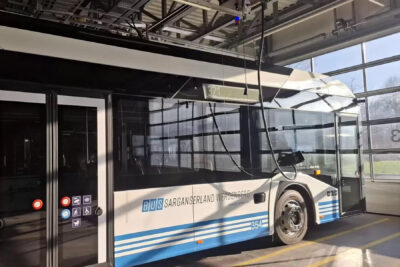

2 Comments